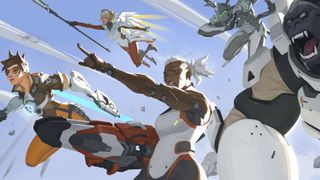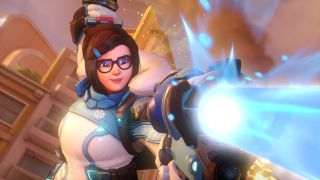In a 5v5 world, Overwatch 2 is still figuring itself out
By kicking two players out, Overwatch veers closer to its FPS competitors.

After a few hours of Overwatch 2's alpha playtest, it finally clicked. I'm a 3,000-hour Overwatch player—obsessive, really—and it took me several games to get what was going wrong for me in the long-awaited sequel to Blizzard's hero shooter. By removing two players, one tank per team, Overwatch smashed the fast forward button on its FPS team fights. 5v5 Overwatch is faster, and I had to play faster.
For me, the most boring heroes to play in Overwatch are the ones with guns. Sniper rifles, railguns, and shotguns can't match the thrill of dodging the stun of a Reinhardt's Earthshatter by crawling up a wall as Genji or the jolt you get from landing a precision arrow headshot as Hanzo. Overwatch is the most satisfying shooter out there if you want to outplay your enemies with movement-based abilities and weapons; it's why a fighting game hero like Doomfist can survive in the chaos of its firefights. Many of its most acrobatic heroes require precision timing based on keen observation of enemy abilities and behaviors. It's a game that often rewards patience and tactical consideration as much as pure aim skill.
All for one
In Overwatch 2, I kept getting crushed while playing one of the game's most mobile heroes, Genji. I wasn't sure what I was missing, especially having spent so many hours refining my playstyle in the original game. Could removing a tank make it that different? I decided to try an experiment and play like I had brownies in the oven and absolutely no time to waste. Every time I saw the enemy Baptiste standing behind his team lobbing healing grenades, I flung shurikens his way and dashed right into him, taking the one-on-one duel. I won the engagement every time, charged my Dragonblade ultimate and got more and more kills.
Without a second tank to back Baptiste up, there was a smaller chance of someone interrupting the fight. For several of the clashes between our two teams where I took this tactic, my team won as a result. Every tank, including Doomfist—who is new to the role—is built to get into the fray fast, and to pounce on weak targets. To be stacked on top of each other is to turn yourselves into easy prey. The threat of mobility from the redesigned tanks, and their inability to consistently defend their teammates, forces you to separate yourself from the pack. You want a tank to have to decide on an individual target to attack, and you want that decision to be a punishable mistake that you can then turn into a victory.
In the original Overwatch, brazenly dashing straight to the enemy's backline isn't smart—it's reckless. You rarely ever want to force a duel, even if it's a support hero who you theoretically would want to eliminate first. Unless it's down to the wire and you have no options left, that level of aggression will often get you killed simply because of the amount of resources you have to expend to start the battle off in the first place. A good enemy team would have noticed my abilities on cooldown and punished me by sending in a tank I have no escape from.

In Overwatch 2, these sorts of risky plays need to happen way more often. Every fight is accelerated in comparison to the original game. The flow of the sequel resembles the 'dive' meta that rose to the surface early in Overwatch's life. In dive, mobile tanks and damage dealers on both teams would race to be the first to erase the opposing team's support players. Every fight was definitive. There were no survivors after an engagement, but as a result, they would respawn and be back to fight again within seconds. The fast-paced dive meta defined early Overwatch because it was the most efficient way to initiate battles and finish them quickly.
The problem with dive, and with Overwatch 2's adherence to this rapid style of play, is you lose the breadth of strategy that's available when you slow everything down. It's why the tank and support roles exist: heroes that solely heal others or soak up tons of damage mean you can't solely rely on aim kill to win the day. While other hero shooters like Valorant, Apex Legends, and Rainbow Six Siege value gunplay above all else, Overwatch makes room for non-traditional forms of FPS skill and heroes that rely on those skills. By removing a whole tank from each team, Overwatch 2 is inching closer to every other FPS.
The biggest gaming news, reviews and hardware deals
Keep up to date with the most important stories and the best deals, as picked by the PC Gamer team.
A shift in identity
Overwatch 2 shows more signs of a traditional shooter with how much ultimate charge has slowed down—again, something that could be tweaked in the future. During the alpha, it was not uncommon to go a whole round as a character like Zenyatta and only earn one Transcendence. Because ultimates charge almost entirely off of damage to smaller, squishy targets now (shooting Tanks builds ult slower), it incentivizes everyone on a team to go for quick kills.
Framing team fights around a collision of lone wolves doing their own thing rather than a group of people with an unspoken strategy robs the game of what makes it so fun.
This homogenization of player goals, especially for players of average skill, leads to games where everyone scatters looking for their own targets. In the games I played, the teams that clumped up and stayed together, which is the range at which many support and tank abilities are most effective, were almost always at a disadvantage to those that spaced out and went for risky kills instead. That this was effective in many of the games I played says a lot about the priorities inherent in Overwatch 2's design.
Success in Overwatch 2 is finding a way to squeeze the enemy team from all directions, and to only gather up to push or capture the objective. Tanks, in part because so few of them have shields, are much more about causing distractions than carving a path toward the enemy team. And because of the speed increase for damage heroes, you end up doing the same thing, albeit more carefully due to your lower health. Playing Doomfist as a tank wasn't notably different from playing him as a DPS; I didn't really have to consider where exactly my team was as long as they were generally nearby.

A lot of abilities, like D.Va's bullet-eating Defense Matrix, were best used selfishly rather than to protect and enable my teammates. Instead of incentivizing you to orbit around each other because of the various abilities in the game, like Ana's healing grenade or Mei's Ice Wall, Overwatch 2 expects you to hope that everyone is on the same page, attacking the same thing. It happens more often than not with two fewer players in the mix, but framing team fights around a collision of lone wolves doing their own thing rather than a group of people with an unspoken strategy based on team composition robs the game of what makes the team-play in the game so fun.
Matches in different skill levels—and with much better matchmaking than the alpha I played—in the final game might tighten this up (low-skill players tend to feel safe in numbers), but the lethality Blizzard has granted most of the heroes would require wide-reaching balance changes to keep from being identified as the most efficient form of play. And as we've seen with other popular playstyles, like having two shield tanks or an Orisa and a Roadhog, it could easily trickle down into the most casual games.
The original Overwatch's DNA isn't all gone in Overwatch 2, but it's minimized enough that it starts to make certain non-aim-based heroes and strategies fall behind when they don't fit into the new rhythm of the game's team fights. Number tweaks can fix this, and I imagine that's the bulk of the work that will go into the beta outside of new hero releases. But Overwatch 2 makes me question whether or not squeezing the game into this slimmer form is worth all the trouble.
Overwatch 2 is already behind its competitors in a lot of ways that don't concern its particular brand of first-person shooting. It's finally getting its first black woman hero in Sojourn, it's finally getting a proper PvE mode, and it will probably have a battle pass too. Back in 2016, Overwatch was the game everyone else copied; it wasn't like anything in the FPS genre at the time, and still isn't in a lot of ways. It has things that need updating, but I'm not sure the fundamental ebb and flow of its gameplay was one of them. Now, in trying to chase the speed of its competition by removing one of its most important hero types from each team, it dilutes what made it so compelling in the first place.
Tyler has covered videogames and PC hardware for 15 years. He regularly spends time playing and reporting on games like Diablo 4, Elden Ring, Overwatch 2, and Final Fantasy 14. While his speciality is in action RPGs and MMOs, he's driven to cover all sorts of games whether they're broken, beautiful, or bizarre.
Most Popular





